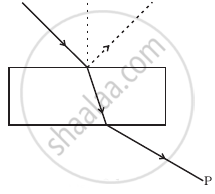Advertisements
Advertisements
प्रश्न
State any two methods by which ordinary light can be polarised
उत्तर
Method I: is bypassing unpolarised light through a polarizer
Method II: is by reflection (Brewster’s law)
APPEARS IN
संबंधित प्रश्न
If the critical angle of a medium is sin-1(3/5), find the polarising angle.
Using the phenomenon of polarisation, show how the transverse nature of light can be demonstrated.
Two polaroids P1 and P2 are placed with their pass axes perpendicular to each other. An unpolarised light of intensity I0 is incident on P1. A third polaroid P3 is kept in between P1 and P2 such that its pass axis makes an angle of 30° with that of P1. Determine the intensity of light transmitted through P1, P2 and P3
Two polaroids P1 and P2 are placed with their pass axes perpendicular to each other. Unpolarised light of intensity I0 is incident on P1. A third polaroid P3 is kept in between P1 and P2 such that its pass axis makes an angle of 60° with that of P1. Determine the intensity of light transmitted through P1, P2 and P3.
The glass plate of refractive index 1.732 is to be used as a polarizer, its polarising angle is _______.
A ray of ordinary light is travelling in air. It is incident on air glass pair at a polarising angle of 56°. Find the angle of refraction in glass.
What is partially polarised light?
List the uses of polaroids.
What is double refraction?
Consider a light beam incident from air to a glass slab at Brewster’s angle as shown in figure. A polaroid is placed in the path of the emergent ray at point P and rotated about an axis passing through the centre and perpendicular to the plane of the polaroid.

